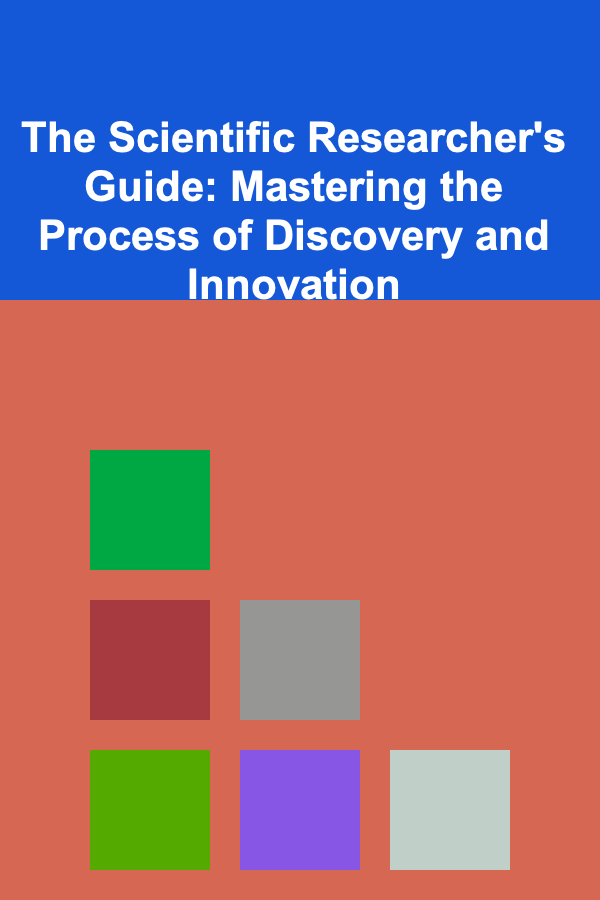
The Scientific Researcher's Guide: Mastering the Process of Discovery and Innovation
ebook include PDF & Audio bundle (Micro Guide)
$12.99$5.99
Limited Time Offer! Order within the next:

Scientific research is the foundation upon which new knowledge is built, driving discovery and innovation across a multitude of disciplines. It is a dynamic and systematic process that requires curiosity, critical thinking, and an unwavering commitment to uncovering truths. However, the path to scientific discovery is not always linear or easy. It requires researchers to master both the art and the science of experimentation, analysis, and communication. This guide is designed to help scientific researchers navigate the process of discovery and innovation, providing a roadmap for conducting effective research, managing challenges, and contributing valuable insights to the scientific community.
Cultivating a Scientific Mindset
Before diving into the technicalities of research, it's essential to foster the right mindset. A scientific mindset goes beyond the ability to design experiments or analyze data---it's about approaching problems with curiosity, skepticism, and a desire to understand the world more deeply. Cultivating this mindset involves developing several key habits:
Embrace Curiosity and Lifelong Learning
At the core of every great scientific discovery is a question. Researchers must constantly ask, "What if?" or "Why?" These questions fuel the pursuit of knowledge. Great scientists are not just experts in their fields---they are learners who continuously seek new information and perspectives.
- Stay curious: Keep questioning existing assumptions and exploring new areas of interest.
- Read broadly: Stay updated on developments in your field and related disciplines to encourage interdisciplinary thinking.
Be Resilient in the Face of Failure
Research rarely produces immediate results, and even when it does, it often leads to new questions rather than clear answers. Embrace setbacks as learning opportunities rather than failures. Some of the greatest scientific breakthroughs have emerged from unexpected results or challenges.
- Develop a growth mindset: Understand that setbacks are a natural part of the scientific process. Every experiment, whether successful or not, provides valuable data.
- Learn from mistakes: Reflect on what went wrong and adjust your approach accordingly.
Adopt Skepticism and Objectivity
Scientific research relies on evidence, not assumptions or personal beliefs. Approach all hypotheses, data, and interpretations with a healthy dose of skepticism, questioning the validity and reliability of results. Objectivity is crucial to ensuring that conclusions are based on facts, not biases or preconceived notions.
- Question your findings: Consider alternative explanations for your data and test them whenever possible.
- Seek peer review: Share your work with others for feedback and constructive criticism.
Designing Robust Research
Once the mindset is in place, it's time to design the research. A well-structured research design ensures that experiments yield meaningful results. Here are the essential steps to create a sound research design:
Defining the Research Problem and Hypothesis
Every scientific investigation begins with a problem or question that needs to be addressed. A well-defined research question is the foundation of a successful study. Equally important is the hypothesis---the proposed answer to the research question. The hypothesis should be based on existing knowledge and offer a clear, testable statement.
- Frame your research question: Be specific about the problem you aim to solve. Broad or vague questions can lead to ambiguous results.
- Develop a hypothesis: Your hypothesis should propose a clear relationship between variables and should be falsifiable (able to be proven wrong through testing).
Choosing the Right Methodology
The methodology refers to the methods you will use to collect and analyze data. The choice of methodology depends on the research question, available resources, and the nature of the data being studied. Common research methodologies include:
- Experimental Research: Involves manipulating one or more variables to observe their effect on another variable. This approach is commonly used in laboratory settings.
- Observational Research: Involves observing phenomena as they naturally occur without manipulation. This method is often used in fields such as ecology and social science.
- Survey and Questionnaire Research: Useful for gathering data from large groups of people, typically used in social sciences.
- Qualitative Research: Focuses on understanding behaviors, perceptions, and experiences, often through interviews or focus groups.
Identifying Variables and Controls
To ensure that the results are valid, researchers must carefully define the variables in their study and control any potential confounding factors. In experimental research, variables are typically divided into:
- Independent Variables: The variables you manipulate to observe their effect on the dependent variable.
- Dependent Variables: The outcomes you measure to determine the effect of the independent variable.
- Control Variables: Factors that could affect the dependent variable but are kept constant to avoid interference.
By clearly identifying these variables and controlling for external factors, you ensure that the results of your experiment are due to the independent variable alone.
Sample Size and Statistical Power
One of the most critical aspects of research design is ensuring that your sample size is large enough to detect a meaningful effect. A small sample size increases the risk of Type I (false positive) and Type II (false negative) errors. Statistical power analysis is often used to calculate the minimum sample size needed to detect significant effects with a desired level of confidence.
- Larger sample sizes improve the reliability of results and reduce the risk of errors.
- Consider the effect size: A small but significant effect might require a larger sample size to detect, while a large effect might be detectable with a smaller sample.
Conducting the Research
With a solid research design in place, it's time to conduct the research. This stage involves implementing your methodology, collecting data, and carefully documenting every step of the process. Here are some key practices to follow during this phase:
Data Collection and Accuracy
The accuracy and reliability of your data are paramount. Whether you are measuring physical quantities, conducting surveys, or making qualitative observations, maintaining high standards of accuracy is essential. Consider the following:
- Use reliable instruments: Whether it's a thermometer, a microscope, or a survey tool, ensure that the instruments you're using are calibrated and appropriate for the task.
- Record data meticulously: Document every detail of the experiment, including any deviations from the planned methodology, as this information may be crucial for interpreting the results.
- Minimize biases: Where possible, blind your experiment or involve multiple researchers in data collection to reduce human error and subjectivity.
Controlling for Confounding Variables
In any experiment, there are a myriad of factors that can influence the outcome. It is essential to control for confounding variables, those external factors that might affect both the independent and dependent variables, leading to spurious results. Strategies for control include:
- Randomization: Randomly assigning subjects to different groups to eliminate selection bias.
- Blinding: Preventing researchers or participants from knowing which treatment or condition they are in to reduce bias in measurement or behavior.
- Counterbalancing: In repeated-measures designs, counterbalance the order in which treatments are applied to avoid order effects.
Analyzing the Data
Once the data is collected, the next step is analysis. This is where the raw data is turned into meaningful insights. The choice of analysis method depends on the type of data and the research question.
Descriptive Statistics
Descriptive statistics provide a summary of the data, including measures of central tendency (mean, median, mode) and measures of variability (range, standard deviation). These statistics help to understand the overall trends in the data and provide a foundation for more complex analyses.
Inferential Statistics
Inferential statistics allow researchers to make conclusions about a population based on a sample of data. Common statistical tests include:
- T-tests: Compare the means of two groups.
- ANOVA: Compares the means of three or more groups.
- Regression analysis: Investigates the relationship between dependent and independent variables.
The goal of inferential statistics is to determine whether observed effects are statistically significant---that is, whether they are likely to be real or just due to random chance.
Interpretation and Context
Interpreting the results requires more than just statistical analysis---it involves placing the findings in the context of the broader research question. This includes considering potential limitations of the study, alternative explanations for the results, and the implications of the findings.
- Statistical significance is not always the same as practical significance. Even a small effect might have real-world implications, especially in fields like medicine or environmental science.
- Replicability: The findings should be reproducible. If the results cannot be replicated in subsequent studies, they may lack reliability.
Communicating the Results
Once the analysis is complete, it's time to communicate your findings to the broader scientific community and the public. Effective communication is essential for ensuring that your research contributes to the body of knowledge and has an impact.
Writing Research Papers
Research papers are the most common way to communicate findings. A well-written paper should clearly describe the problem, methodology, results, and interpretation. Common sections of a research paper include:
- Abstract: A concise summary of the study's purpose, methods, results, and conclusion.
- Introduction: Background information and the research question.
- Methods: A detailed description of the experiment or study design.
- Results: A presentation of the data, often with tables, graphs, and statistical analyses.
- Discussion: Interpretation of the results, limitations, and implications.
- Conclusion: A summary of the findings and suggestions for future research.
Presentations and Conferences
In addition to written papers, many researchers present their findings at conferences. This is an opportunity to share insights, gain feedback, and network with other scientists. Effective presentations require clear visuals, concise messaging, and the ability to engage the audience.
Public Engagement
Science is not only for the scientific community but for society at large. Researchers should strive to make their findings accessible to the public, especially when their work has practical applications or societal implications. This can include writing for general audiences, engaging with the media, or working with policymakers.
Conclusion
The process of scientific research is a complex but deeply rewarding journey of discovery and innovation. By cultivating the right mindset, designing robust studies, and mastering the art of data collection, analysis, and communication, researchers can contribute valuable insights to their fields. The path to discovery may be challenging, but it is through the rigorous pursuit of knowledge that we push the boundaries of what is known and continue to shape the future.

How to Create a Website Security Checklist for Beginners
Read More
How to Design a Home Office During Your Renovation
Read More
How To Explore Dwarf Planets and the Kuiper Belt
Read More
How to Reduce Noise from HVAC Systems in Your Home
Read More
How to Soundproof Your Home Against Street Noise
Read More
The Art of Data Entry: Techniques for Speed, Precision, and Consistency
Read MoreOther Products

How to Create a Website Security Checklist for Beginners
Read More
How to Design a Home Office During Your Renovation
Read More
How To Explore Dwarf Planets and the Kuiper Belt
Read More
How to Reduce Noise from HVAC Systems in Your Home
Read More
How to Soundproof Your Home Against Street Noise
Read More